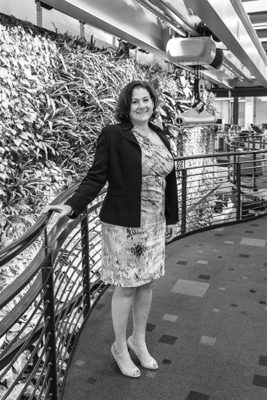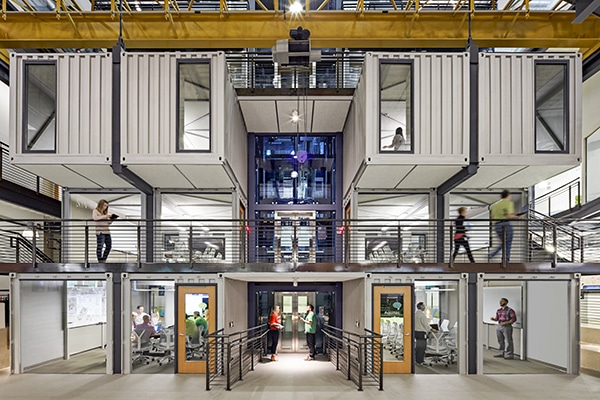
Jenna Geigerman, senior manager of real estate and strategy for Fort Lauderdale, Florida-based tech firm Citrix, has worn a lot of hats in her career. “I’ve taken every job in commercial real estate but attorney—though I’ve definitely played one on TV,” she jokes. In her current role, though, she gets the chance to combine her skills and experience in design, architecture and development to innovate the company’s workspaces from top to bottom with twenty-first-century technology.
“The part of the job I enjoy the most is working with people to develop solutions and make things work better for them,” Geigerman says. When considering how best to improve Citrix’s existing workspaces, she always asks herself, “What is the world of possibility? We know how we work now, but how could we work differently?” In her work, she juggles the numerous concerns of user engagement, technology, communication, and management to make sure her build-outs meet the goals of Citrix’s workers.
Citrix’s portfolio for its work spaces is in a constant state of evolution, with different kinds of spaces needed to meet user preferences in each location. “Historically, a lot of our portfolio is offices, cubes, high and low walls,” Geigerman says. When making changes to the portfolio, the team strikes a balance between creating new spaces and renovating the old ones.
Technology is an important component of Citrix’s next-generation offices. “Before laptops, we were largely confined to our desks to work,” Geigerman says. “The laptop allows us to evolve past that. Plus, with phones and tablets, we can really work anywhere, on any device.” Because of this, many of Geigerman’s next-generation offices include tech solutions that allow workers to move to their preferred work spaces with zero wireless interruption.

Citrix’s Paddington, UK office, for instance, has 100 percent wireless connectivity, requiring an infrastructure strong enough to address movement by a large user base. Also, Geigerman is switching out the Raleigh, North Carolina, office’s wired connections for Bluetooth capability and the Citrix Workspace Hub, which will allow workers to authenticate and cast content no matter where they are in the workplace. In terms of space usage, her team is replacing the Raleigh office’s obsolete bench seating with more tailored work spaces that account for how the staff works today. Geigerman’s ultimate goal in Raleigh is to create mobile, cloud-based, dynamic work spaces that managers can easily stop by to have conversations with their employees.
Elsewhere, at Citrix’s Fort Lauderdale headquarters, Geigerman is currently in early-stage user-engagement discussions to learn how best to upgrade the human resources office, and her notes will inform the design and development phase of the project. Among other things, she has recognized that the redesign of the department’s space will need to strike a balance between confidentiality and openness. Some of the proposed changes include a concierge center and easy-to-find rooms where HR personnel can interview employees in an engaging environment.
Citrix’s outside partners have enjoyed working on the space as well, including BHDP Architecture. “Citrix has been an ideal collaborative partner in the design of their new workplace environments,” says Chris LaPata, a client leader with BHDP. “Together, we’ve proven how space can improve organizational performance by positively impacting the work behaviors to achieve their business objectives.”
Updating Citrix’s spaces is about more than making the company’s own workers happier and more productive; it’s also the best way to advertise the company’s services. Geigerman wants to make sure the company’s spaces reflect its core values of integrity, respect, curiosity, courage, and unity. “We’re also giving the customer an idea of how their work space can function by seeing it in action in Citrix offices,” she says.
And how does Geigerman want the ideal Citrix work space to work? “When you come to work, you have access to the tools and information you have in your home life,” she says. “I should be able to find where people are sitting, ask Alexa to play music, pull up content easily on any screen, and move between spaces without interruption. Employees in the office should have access to all things in all places.”
Photos: MF Design Studio, Chale Zegarra, Robert Benson Photography



